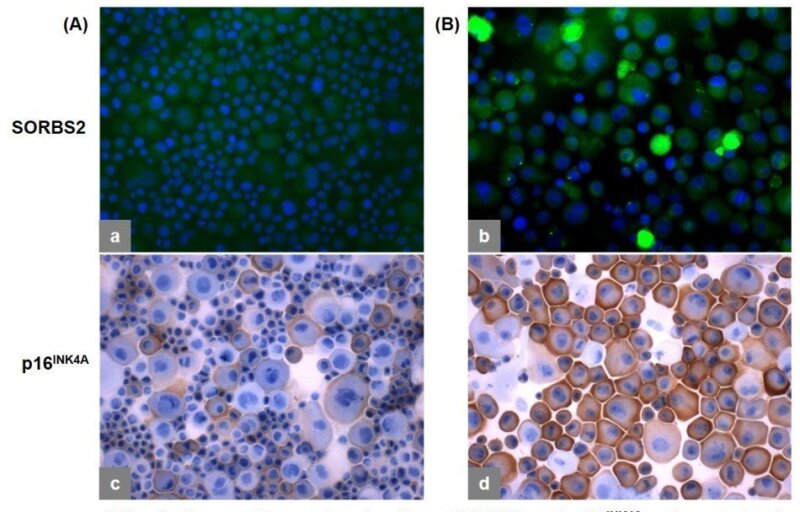Women's Hospital, Jena University Hospital
Endogenous expression of the genes SORBS2 (green fluorescence) (a,b) and p16INK4A (brown precipitates) (c,d) during in vitro passaging of primary keratinocytes at different time points of passaging (A) early passage and (B) late passage (nearly senescent stage) was performed. Strong endogenous immuncytochemical staining (accordingly high gene expression) of SORBS2 (b) and p16INK4a (d) in the later passage (B) suggests that these genes may be of relevance for senescence. (magnification ×200)
Picture: Liesenfeld M, Mosig S, Funke H, Jansen L, Runnebaum IB, Dürst M, Backsch C. SORBS2 and TLR3 induce premature senescence in primary human fibroblasts and keratinocytes. BMC Cancer. 2013 Oct 29;13:507.Research topic(s)
Incidence of breast, ovarian and endometrial cancer is increasing with age. In addition, many women older than 50 years suffer from symptoms like incontinence caused by pelvic organ prolapse.
At Women’s University Hospital JenaExternal link, intense research activities aim to improve and expand prevention, early detection and therapy of age-associated diseases in women. We participate in several multi-centric clinical trials for new chemotherapeutics. Our in-house clinical research focuses on optimization of surgical therapy with maximization of the curative result and minimization of adverse effects (key aspects: pain, complications, quality of life).
In our molecular biology laboratory, new markers for diagnosis, prognosis and therapy monitoring of age-related carcinosis are investigated. Furthermore, new chemotherapeutic substances and their mode of action are studied. Functional characterization of potential tumor suppressor genes (e.g. SORBS2, which is associated with cell ageing, see figure) with relevance in pathogenesis of cervical carcinoma, helps to elucidate the process of malignant transformation. This opens up the possibility for identification of new molecular markers.
With our research, we contribute to the development of individual, tailored treatment for each patient. Furthermore, new options are opened for patients, who do not sufficiently respond to established therapies.
Methods
- Prospective clinical studies
- QUIPS (international counterpart: PAIN OUT), a quality improvement and registry project based on a web-based information system to improve treatment of patients with post-operative pain
- Retrospective data analysis using modern database systems
- Patient surveys
- Kaplan-Meier analysis, multivariate regression analysis
- Collection and analysis of tissue samples
- Generation of immortal cell lines from tumor tissue samples
- Methods for identification of epigenetic and genetic abberations (e. g. methylation specific PCR, in situ fluorescence hybridisation)
- 2D- and 3D- cell culture methods and assays (e. g. proliferation, cytotoxicity, migration, invasion, senescence, apoptosis)
- Immunohistochemical analysis
Selected publications
Runnebaum IB, Kather A, Sehouli J. (2022) Die opportunistische Salpingektomie (OS) als Ovarialkarzinom-Prävention entwickelt sich zum neuen De-Facto-Standard in Deutschland. Deutsches Ärzteblatt
Hildebrandt J, Häfner N, Kritsch D, Görls H, Dürst M, Runnebaum IB, Weigand W. (2022) Highly cytotoxic osmium(II) compounds and their ruthenium(II) analogues targeting ovarian carcinoma cell lines and evading cisplatin resistance mechanisms.External link Int J Mol Sci, 23(9):4976
Cruz JJ, Kather A, Nicolaus K, Rengsberger M, Mothes AR, Schleussner E, Meissner W, Runnebaum IB. (2021) Acute postoperative pain in 23 procedures of gynaecological surgery analysed in a prospective open registry study on risk factors and consequences for the patient.External link Sci Rep, 11(1):22148
Mothes AR, Mothes HK, Kather A, Altendorf-Hofmann A, Radosa MP, Radosa JC, Runnebaum IB. (2021) Inverse correlation between urethral length and continence before and after native tissue pelvic floor reconstruction.External link Sci Rep, 11(1):22011
Beiersdorf J, Scheungraber C, Wunsch K, Schmitz M, Hansel A, Hoyer H, Gajda M, Greinke C, Runnebaum IB, Dürst M, Backsch C. (2020) Combined assessment of 3q26 amplification and promoter methylation in patients with high grade cervical lesions show age specific differences.External link Genes, Chromosomes & Cancer, 59(3):168-177
Links

07747 Jena Google Maps site planExternal link

07747 Jena Google Maps site planExternal link

07747 Jena Google Maps site planExternal link

07747 Jena Google Maps site planExternal link
